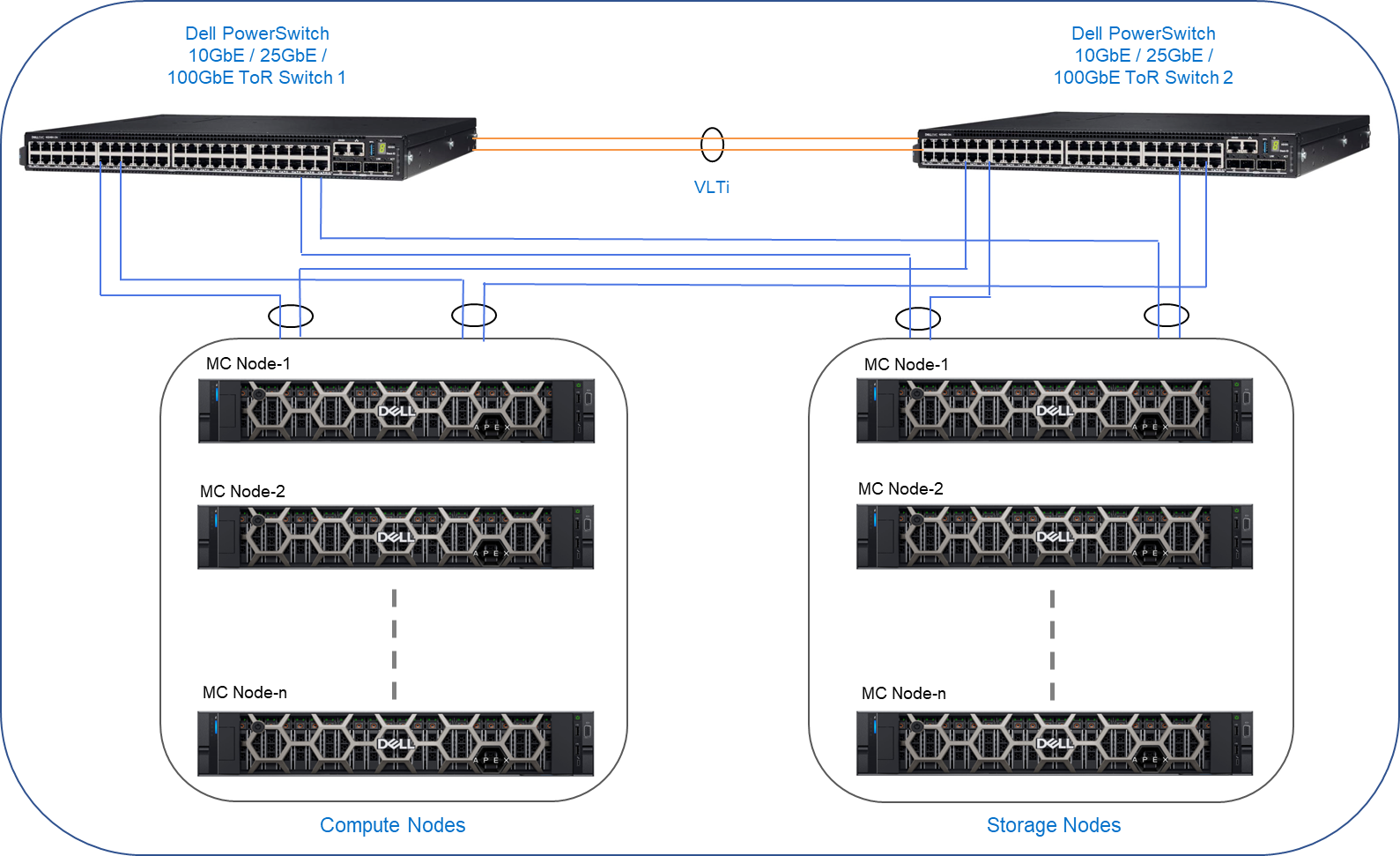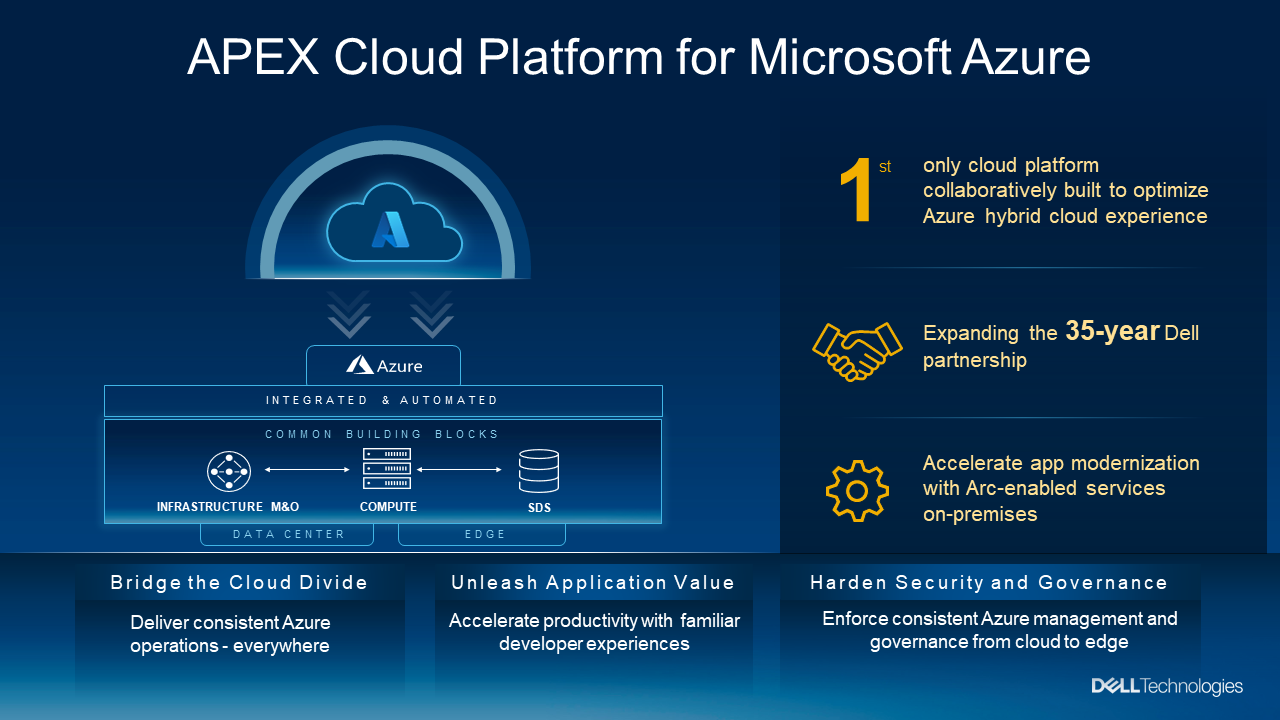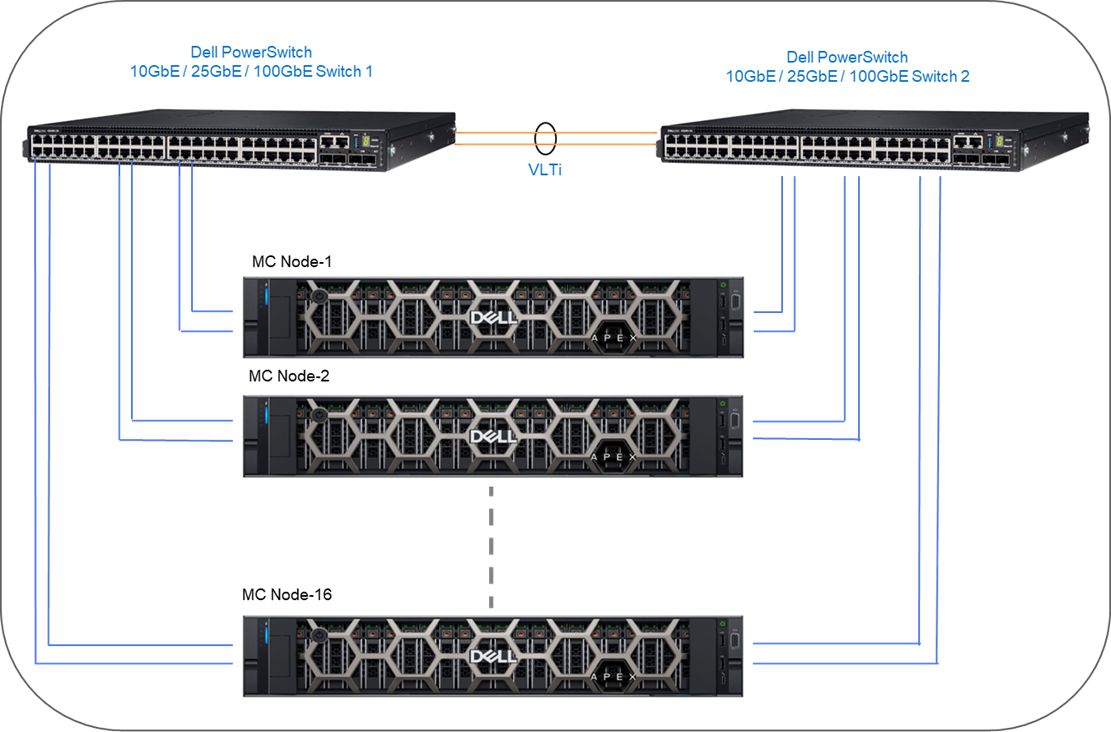Assets

Unleash Innovation Through Dell APEX Cloud Platform (ACP) for Red Hat OpenShift with Dell PowerSwitch
Wed, 20 Dec 2023 19:24:30 -0000
|Read Time: 0 minutes
Unleash Innovation Through Dell APEX Cloud Platform (ACP) for Red Hat OpenShift, In Synergy with Dell PowerSwitch
Organizations are leveraging containerized multicloud deployments to boost revenue, enhance efficiency, and elevate user experiences. Multicloud is the go to choice for organizations, with Kubernetes at the forefront. Among them, 42% opt for Red Hat OpenShift to manage their containers.1 Yet, multiple clouds can introduce complexity. Modern multicloud container setups demand consistent operations and robust automation for IT peace of mind, enabling a focus on delivering application value over infrastructure management.
Dell APEX Cloud Platform for Red Hat OpenShift
The Dell APEX Cloud Platform for Red Hat OpenShift is a collaborative solution developed in partnership with Red Hat, it enhances and streamlines on-premises OpenShift deployments, offering an integrated operational experience. The key features include:
- Seamless Integration and Intelligent Automation: This platform offers deep integration and intelligent automation across the Dell and OpenShift technology stacks. This integration accelerates time-to-value and eliminates the complexities that are associated with managing these technologies separately by different tools and portals.
- Unified Management: Users benefit from simplified, integrated management through the OpenShift Web Console, making it more straightforward to oversee and control the platform's components.
- Bare Metal Architecture: The platform is built on a bare metal architecture, which ensures high performance, predictability, and linear scalability. This robust foundation meets and exceeds even the most demanding Service Level Agreements (SLAs).
- Reduce cost and complexity: Dell APEX Cloud Platform for Red Hat OpenShift delivers everything that you need to rapidly deploy and run Red Hat OpenShift on a turnkey, integrated bare metal infrastructure. The extensive automation enabled by the Dell APEX Cloud Platform Foundation Software slashes deployment time by over 90%, while reducing time for complex life cycle management tasks by up to 90%.2 Further, Dell Technologies performed over 21,000 hours of interoperability testing for each major release, ensuring predictability and reliability.
- Optimize workload outcomes: By optimizing delivery of OpenShift on-premises, the platform helps accelerate application modernization initiatives. Built on the next-generation Dell PowerEdge servers and Dell’s scalable, high-performance Storage Data Server (SDS), the platform delivers stringent SLAs for a broad range of modern mission-critical workloads. Further, with a universal storage layer between on-premises Dell APEX Cloud Platform and Dell’s APEX Storage for Public Cloud, the platform facilitates simpler movement of workloads across your IT estate.
- Enhance security and governance: Based on the cyber-resilient foundation of next-generation PowerEdge nodes, the Dell APEX Cloud Platform accelerates Zero Trust adoption, while providing multi-layer security and governance capabilities built throughout the technology stack. Further, with a bare metal implementation, the platform enhances security by reducing the potential attack surface.
 Figure 1 APEX Cloud Platform for Red Hat OpenShift.
Figure 1 APEX Cloud Platform for Red Hat OpenShift.
Dell Networking Advantage
Dell Networking with Enterprise SONiC is a Linux-based highly scalable, cloud-ready data center network fabric that helps IT organizations create a modern network infrastructure. This modern network infrastructure meets constantly shifting business demands, increases productivity, delivers services faster and remains flexible by incorporating the latest technology innovations like automation, multicloud, and generative AI.
Salient features include:
- Innovation by collaborating with and contributing to the open-source SONiC community.
- Container-based Automation and Visibility.
- Supports a broad portfolio of high-performance data center and edge PowerSwitch options.
- Expanding ecosystem of partner automation/orchestration applications.
- A growing set of validated use cases, to meet the needs of large enterprises, Telcos, cloud service providers, large retailers and so on.
Dell Networking for ACP for Red Hat OpenShift
The Dell APEX Cloud Platform (ACP) for OpenShift addresses network considerations that are related to availability, performance, and scalability. This platform, which has undergone testing with Dell networking, enables organizations to swiftly deploy the overall solution by referring to the deployment guide and reference architecture. Dell Technologies manufactures APEX Cloud Platforms for OpenShift in the factory, per customers’ purchase order, and delivers to their data centers, ready for deployment. Dell tested the overall solution with Dell PowerSwitch platforms. The nodes in the APEX Cloud Platforms for OpenShift attach to Dell’s Top of Rack (ToR) networking switch which meets the ACP for Red Hat OpenShift network functional requirements which, at a high level, are as follows:
- 25G/100G Network Interface Controllers (NICs) support.
- 802.3ad Link aggregation Control Protocol (LACP) support.
- Maximum Transmission Unit (MTU) Size: 1500 for management and 9000 for Data.
- Disabling option for IPv6 multicast snooping to ensure proper discovery of nodes.
- VLAN support: Tagged 3939 for node discovery and Native 0 for external management.
Network redundancy and performance considerations
APEX Cloud Platform for OpenShift is a software-defined data center which depends on the physical top‑of-rack switching for network communications and is engineered to enable full redundancy, plus failure protection across the cluster. For customer environments that require protection from a single point of failure, you must design and configure the adjacent network supporting the ACP for OpenShift cluster to eliminate any single point of failure. A site must deploy a minimum of two Dell ToR PowerSwitches to support high availability, plus balance the workload on the ACP for OpenShift cluster. A pair of cables (VLT Connection) link these Dell PowerSwitches to support the flow of Layer 2 traffic between the ToR switches.
 Figure 2 ACP for Red Hat OpenShift networking diagram.
Figure 2 ACP for Red Hat OpenShift networking diagram.
Dell-on-Dell value proposition
Having an end-to-end stack from Dell Technologies enables customers to build a cohesive and efficient IT infrastructure. This allows customers to focus on their core business objectives rather than managing complex and disparate infrastructure components. Dell-on-Dell’s value proposition for integrated networking, storage, and compute solutions offers the following benefits:
- Seamless integration of Dell networking with Dell APEX Cloud Platform for Red Hat OpenShift which simplifies deployment, management, and maintenance, plus reduces the risk of interoperability issues.
- Dell APEX Cloud Platform for Red Hat OpenShift deployed, with Dell Networking, optimizes, and overall provides better system performance.
- Single point of support across overall deployment provides a consistent service experience.
- Dell APEX Cloud Platform for Red Hat OpenShift solution, with Dell networking, offers competitive pricing compared to stand-alone components from various vendors.
- Reduced complexity and efficient management translates into lower operational expenses (OPEX).
- Regular and seamless system updates across the ACP for OpenShift ecosystem.
Useful resources
- Internal: Dell APEX Cloud Platform for Red Hat OpenShift
- Public: Dell APEX Cloud Platform for Red Hat OpenShift
- Dell Enterprise SONiC
1 Red Hat, “State of Kubernetes Security Report,” 2022.
2 Based on internal testing, August 2023, and September 2023.

Foster innovation with Dell APEX Cloud Platform (ACP) for Microsoft Azure with Dell PowerSwitch
Thu, 30 Nov 2023 19:51:55 -0000
|Read Time: 0 minutes
Modern enterprises depend on their IT departments to facilitate their intricate operations and maintain a competitive edge in the market. To secure their competitiveness and achieve success, these companies aspire to develop groundbreaking applications and services with remarkable agility. Many Businesses are embracing a multicloud approach to fuel their inventive endeavors and expedite the deployment of applications.
Dell APEX Cloud Platform for Microsoft Azure is a hyperconverged infrastructure (HCI) solution that is engineered collaboratively with Microsoft. The solution optimizes Azure hybrid cloud operations which consolidates compute, storage, and network into a single, highly available, unified system. With proper planning, ACP for Azure rapidly deploys into an existing data center environment, and the end-product is immediately available to deploy applications and services.

Figure 1 APEX Cloud Platform for Microsoft Azure.
Dell Networking for Dell APEX Cloud Platform for Azure
The network considerations for Dell APEX Cloud Platform for Azure are no different than any enterprise IT infrastructure: Availability, Performance, and Scalability. Dell Technologies manufactures APEX Cloud Platforms (MC760 and MC660) for Azure in the factory, per customer’s purchase order and delivers to the customer’s data center, ready for deployment. Dell has tested the overall solution with Dell PowerSwitch platforms. The nodes in the ACP for Azure attach to Dell’s Top of Rack (ToR) networking switch which meets the Microsoft Azure Stack HCI network functional requirements.
Following are the prime requirements for networking:
- Priority Flow Control (PFC) – You require PFC where you use Data Center Bridging (DCB). Since you can use DCB in both iWARP Remote Direct Memory Access (RDMA) and RDMA over Converged Ethernet (RoCE) scenarios, you need PFC in all scenarios.
- Enhanced Transmission Select (ETS) – You need ETS where you use DCB. Since you can use DCB in both RoCE and iWARP RDMA scenarios, you require ETS in all scenarios.
- Link Layer Discovery Protocol (LLDP) – You require LLDP as it enables troubleshooting of physical networking configurations. You must dynamically enable configuration of the LLDP Type‑Length‑Values (TLVs).
- The required organizationally specific custom TLV (TLV Type 127) subtypes are:
- Port VLAN ID (Subtype 1)
- VLAN Name (Subtype 3) – Minimum 10 VLANs support
- Link Aggregation (Subtype 7)
- ETS Configuration (Subtype 9)
- ETS Recommendation (Subtype A)
- PFC Configuration (Subtype B)
- Maximum Frame Size (Subtype 4)
- For Software-Defined Networking (SDN) encapsulation, you require a Maximum Transmission Unit (MTU) range of 1514 to 9174.
- You require Border Gateway Protocol (BGP) to enable tenant workloads with SDN and dynamic peering.
- Also, you need a Dynamic Host Configuration Protocol (DHCP) relay agent for Preboot Execution Environment (PXE) boot services.
Network redundancy and performance considerations
ACP for Azure is a software-defined data center which depends on the physical top-of-rack switching for network communications and is engineered to enable full redundancy, plus failure protection across the cluster. For customer environments that require protection from a single point of failure, you must design and configure the adjacent network supporting the ACP for Azure cluster to eliminate any single point of failure. A site must deploy a minimum of two Dell Top-of-Rack PowerSwitches to support high availability, plus balance the workload on the ACP for Azure cluster. A pair of cables (VLT Connection) links these Dell PowerSwitches which supports the flow of Layer 2 traffic between the ToR switches.
Scalable ACP networking topologies for Azure
Customers can implement various networking topologies to expand to a maximum cluster size of 16 nodes. Dell offers the following scalable networking topologies for APEX Cloud Platform for Azure:
- Fully converged – RDMA, cluster management, and VM traffic traverse the same Ethernet connections thus conserving on switch ports and cabling requirements per node.
- Non-converged – Separates RDMA and host management/VM traffic on to separate network adapter interfaces. This ensures that there is no contention between storage and LAN communications, plus is easier to troubleshoot.

Figure 2 Dell’s scalable ACP network topologies for Azure example.
Dell-on-Dell value proposition
Having an end-to-end stack from Dell Technologies enables customers to build a cohesive and efficient IT infrastructure. This allows customers to focus on their core business objectives rather than managing complex and disparate infrastructure components. Dell-on-Dell’s value proposition for integrated networking, storage, and compute solutions offers the following benefits:
- Seamless integration of Dell networking with Dell APEX Cloud Platform for Azure which simplifies deployment, management, and maintenance, plus reduces the risk of interoperability issues.
- Dell APEX Cloud Platform for Azure, deployed with Dell Networking, optimizes and overall provides better system performance.
- Single point of support across overall deployment, provides a consistent service experience.
- Dell APEX Cloud Platform for Azure solution, with Dell networking, offers competitive pricing compared to stand-alone components from various vendors.
- Reduced complexity and efficient management translates into lower operational expenses (OPEX).
- Regular and seamless system updates across the ACP for Azure ecosystem.

